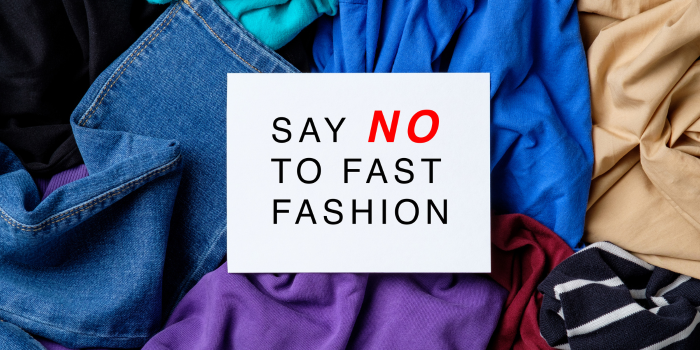Fast fashion is a term that describes the quick turnover of fashion trends and the move towards cheap, mass-produced clothing. Fast fashion has made trendy clothing affordable and accessible, but at what cost? Fast fashion has a significant negative impact on the environment, workers, and consumers. It is responsible for a large amount of greenhouse gas emissions and water pollution and relies on synthetic materials derived from petrochemicals.
Fast fashion also contributes to the exploitation of workers in the Global South, who are exposed to abuse, unsafe conditions, unlivable wages, and excessive hours. Additionally, fast fashion promotes a throwaway culture and excessive consumerism, making clothes disposable commodities.
In this article, we will explore the impact of fast fashion on our planet in more detail, and provide some tips on how to reduce your fashion footprint and support more sustainable alternatives.
How does fast fashion affect the environment?
Fast fashion has a huge environmental impact, from the production of raw materials to the disposal of waste. Here are some of the main ways that fast fashion harms the environment:
- Greenhouse gas emissions: Fast fashion emits 1.2 billion tons of CO2 per year, more than air travel and shipping combined1. This contributes to global warming and climate change, which threaten biodiversity, human health, and food security.
- Water consumption: Fast fashion consumes a lot of freshwater to produce clothing. For example, it takes about 2,700 liters of water to make one cotton t-shirt1. That’s enough water for one person to drink for 900 days. Fast fashion also depletes groundwater and surface water sources, affecting local communities and ecosystems.
- Water pollution: Fast fashion produces 20% of global wastewater, contaminating rivers, oceans, drinking water and soil1. This is mainly due to the use of toxic textile dyes and chemicals that are dumped into the water without proper treatment. These substances can harm aquatic life, cause diseases, and disrupt natural cycles.
- Synthetic materials: 60% of clothes are made of synthetic materials derived from petrochemicals1. These materials are not biodegradable and can take hundreds of years to decompose. They also release microplastics into the water when washed, which can end up in the food chain and affect human health.
- Waste generation: Fast fashion generates a lot of waste due to its low quality and short lifespan. According to the UN, the fashion industry produces 92 million tons of textile waste per year1. Most of this waste ends up in landfills or incinerators, where it releases more greenhouse gases and toxins into the air.
How does fast fashion affect workers?
Fast fashion affects not only the environment but also the people who work to produce it. Most of these workers are women and children in developing countries, who face harsh and unfair working conditions. Here are some of the main ways that fast fashion harms workers:
- Low wages: Fast fashion workers are paid very low wages that do not cover their basic needs. According to Oxfam , garment workers in Bangladesh earn as little as $0.35 per hour2. That’s less than 2% of what they need to live a decent life. Many workers also face wage theft, delayed payments, or no payments at all.
- Long hours: Fast fashion workers are forced to work long hours without breaks or overtime pay. They often work 14-16 hours a day, seven days a week3. This leaves them with little time for rest, family, or education. Many workers also face pressure to meet unrealistic targets or deadlines, which can lead to stress and fatigue.
- Unsafe conditions: Fast fashion workers are exposed to unsafe and unhealthy conditions in factories that lack ventilation, fire safety, or sanitation. They are also exposed to hazardous substances such as dust, chemicals, or heavy metals that can cause respiratory problems, skin irritation, or cancer. Moreover, fast fashion workers are vulnerable to accidents or injuries due to faulty machinery or lack of protective equipment.
- Abuse and violence: Fast fashion workers are often subjected to abuse and violence from their employers or managers. They can face verbal harassment, physical assault, sexual harassment, or rape. They can also face discrimination based on their gender, ethnicity, or religion. Furthermore, fast fashion workers have little or no access to legal or social protection and are often denied their rights to organize, bargain, or strike.
How does fast fashion affect consumers?
Fast fashion affects not only the environment and workers but also the consumers who buy it. Fast fashion creates a culture of overconsumption and disposability, which can have negative consequences for consumers’ well-being and values. Here are some of the main ways that fast fashion harms consumers:
- Quality and durability: Fast fashion clothes are made of low-quality materials and poor craftsmanship, which means they are likely to break, tear, or fade after a few wears or washes. This can lead to dissatisfaction, frustration, or waste of money. Moreover, fast fashion clothes are not designed to last or to be repaired, which means they are destined to be thrown away sooner or later.
- Style and identity: Fast fashion clothes are based on fleeting trends and mass-produced styles, which means they lack originality, creativity, or personality. This can lead to boredom, insecurity, or loss of identity. Moreover, fast fashion clothes can create pressure to keep up with the latest fashions or to fit in with the crowd, which can affect consumers’ self-esteem or sense of individuality.
- Ethics and values: Fast fashion clothes are made at the expense of the environment and workers, which means they are unethical, irresponsible, or harmful. This can lead to guilt, ignorance, or indifference. Moreover, fast fashion clothes can create a disconnect between consumers and the true cost of their purchases, which can affect their awareness or empathy.
How can you reduce your impact of fast fashion?

Fast fashion has a huge impact on our planet, but there are ways to reduce it and to support more sustainable alternatives. Here are some tips on how to reduce your impact of fast fashion:
- Buy less: The most effective way to reduce your impact of fast fashion is to buy fewer clothes in general. This can help you save money, space, and resources. You can also avoid impulse buying or buying clothes that you don’t need or love. You can try to adopt a minimalist wardrobe or a capsule wardrobe, which consists of a few versatile and high-quality pieces that can be mixed and matched for different occasions.
- Buy better: Another way to reduce your impact of fast fashion is to buy better clothes that are more durable, ethical, and eco-friendly. You can look for clothes that are made of natural, organic, or recycled materials, such as cotton, linen, hemp, wool, silk, or polyester. You can also look for clothes that are certified by labels such as Fairtrade, GOTS, OEKO-TEX, or BCI, which indicate that they meet certain standards for social and environmental responsibility. You can also look for clothes that are made by local, independent, or ethical brands, such as Patagonia, Reformation, Everlane, or People Tree, which have a transparent and sustainable business model.
- Buy second-hand: Another way to reduce your impact of fast fashion is to buy second-hand clothes that are pre-loved, vintage, or thrifted. You can find second-hand clothes in online platforms such as Depop, Poshmark, ThredUp, or Vinted, or in local shops such as charity shops, flea markets, or swap parties. Buying second-hand clothes can help you save money, find unique and original pieces, and extend the life of clothes that would otherwise end up in landfills.
- Care for your clothes: Another way to reduce your impact of fast fashion is to care for your clothes properly and make them last longer. You can wash your clothes less frequently, use cold water and gentle detergents, air dry them instead of using a dryer, and store them in a cool and dry place. You can also repair your clothes if they are damaged, mend them if they are torn, or alter them if they don’t fit. You can learn some basic sewing skills or use some no-sew methods to fix your clothes yourself, or take them to a tailor or a repair shop if you need professional help.
- Donate or recycle your clothes: Another way to reduce your impact of fast fashion is to donate or recycle your clothes if you don’t want them anymore. You can donate your clothes to charities, shelters, or organizations that can give them to people in need, such as Oxfam, Salvation Army, or Dress for Success. You can also recycle your clothes by taking them to collection points, drop-off boxes, or recycling centers that can turn them into new products, such as H&M, Zara, or Levi’s. You can also upcycle your clothes by transforming them into something new and useful, such as accessories, home decor, or cleaning clothes.
Conclusion
Fast fashion has a huge impact on our planet, but we can reduce it by making more conscious and responsible choices when it comes to our wardrobe. We can buy less, buy better, buy second-hand, care for our clothes, and donate or recycle our clothes. By doing so, we can not only save money, space, and resources, but also express our style, identity, and values. We can also support more sustainable and ethical alternatives that respect the environment and workers. We hope you enjoyed this article and found some inspiration for your next fashion adventure. And don’t forget to subscribe to our newsletter for more tips, tricks, and resources on living a more eco-friendly and frugal life. Until next time, stay green and stay happy! 😊

Iryna wants to make this world a better, greener place with less waste. Her mission is to protect the planet from plastic pollution by bringing awareness to this global crisis through her website. Send her an email to learn more about her mission and how we can help!






